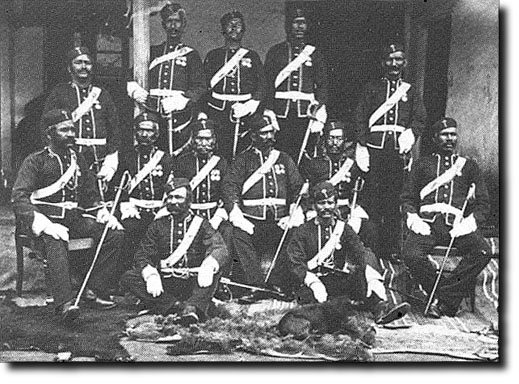|
|

 |
|
The red coats of the 66th had white facings. When they became a light infantry regiment in 1861, they continued to wear red. The 'zouave' style of tunic was adopted in 1869 with white cuffs and green down the front. Officers wore a low pillbox cap with a bugle-horn badge and a '1' underneath. Rank was denoted by crossed swords on the collar. They also had a white pouchbelt with whistle and chain. Undress wear was white or khaki. In 1885. the Viceroy, Lord Dufferin suggested that the 66th should wear rifle green instead of red but it was pointed out that the Nepalese recruits were attracted to the 'Lal Kurti paltan' (red-coated regiment) and that the ensuing loss of their colours would mean that the swearing-in ceremony would be defunct. The matter was dropped but the next year a 2nd battalion was raised which chose to dress in green, so the 1st battalion reluctantly followed suit. In remembrance of their red coats, they were given red facings to their uniforms. In 1891 the forage cap had red piping on the top and crossed kukris with a silver 1 on a scarlet cord boss. The rifle green tunic of native officers had a slashed cuff edged in scarlet and three buttons on each slash. The rank badges were now on the shoulder, being stars and crowns instead of crossed kukris or swords. The British Officers wore helmets covered in green cloth that looked black but when King George V saw them at the Delhi Durbar in 1912 he showed his disapproval and they were changed to white. The fittings were bronze with a silver 5 pointed star on the plate but they changed to silver in 1906 when the Prince of Wales's feathers were added. In 1911 lines were worn, following the practice of British rifle regiments. The tunic was the same as the Kings Royal Rifle Corps except for the width of the black braid on the scarlet collar which was slightly narrower. Overalls were green with black braid down the seams. Black leather belts and gloves were worn. The peakless forage cap was replaced in the last few years of the 19th century by a peaked forage cap with black braid and red piping round the top. Native officers retained the Kilmarnock forage cap with no badge on the front. The band in the Victorian era were dressed in 'Childers' Lowland pattern tartan but this changed in 1907 to a dark green pattern with red stripes designed by H B Mackintosh of Elgin. By 1920 there was no plaid worn by the band. |
Armed Forces | Art and Culture | Articles | Biographies | Colonies | Discussion | Glossary | Home | Library | Links | Map Room | Sources and Media | Science and Technology | Search | Student Zone | Timelines | TV & Film | Wargames
